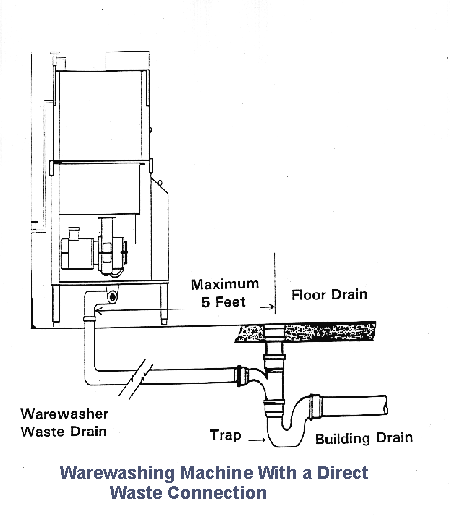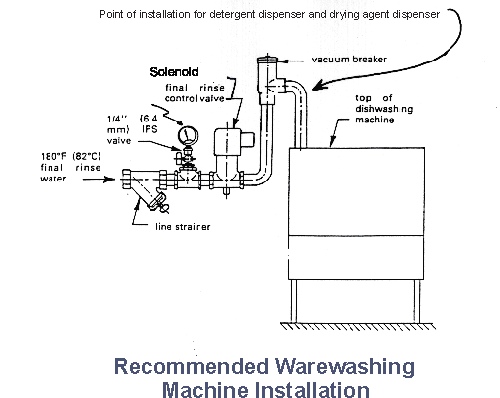
Figure #8-1

Figure #8-2

Figure #8-3
| Food and Drug
Administration and Conference for Food
Protection
FOOD ESTABLISHMENT PLAN REVIEW
GUIDE |
SECTION III
FOOD ESTABLISHMENT GUIDE FOR DESIGN, INSTALLATION, AND CONSTRUCTION RECOMMENDATIONS
MANUAL WAREWASHING
For manual washing and sanitizing of utensils, provide a stainless steel sink with no fewer than 3 compartments. The sink compartments shall be large enough to hold the largest pot, pan or piece of equipment. Each compartment shall be supplied with adequate hot and cold potable running water. Integral drainboards of adequate size shall be provided on both sides of the sink for cleaned and soiled utensils. When approved, 2 compartment sinks may be allowable under certain conditions. See figure #8-1.
Pitch the drainboards and dish tables a minimum of 1/8" per foot and direct the drainage into the sink. Drainboards should generally be at least the same size as that of the sink compartments. Recommended size is 36-48" long and 30" wide.
Locate a floor drain in the immediate vicinity of the sink in areas where wet pots, utensils and equipment are air-drying. Approved racks, shelves or dish tables are to be provided adjacent to the warewash sink.
Provide adequate facilities for preflushing or prescrapping equipment and utensils.
An approved chemical test kit for determining sanitizer strength shall be available and used.
Working supplies of cleaners and sanitizers must be stored in an approved location. A recommended storage location is on a wire shelf below the drainboard of the 3 compartment sink.
MECHANICAL WAREWASHING
The waste line for all mechanical warewashing machines must not be directly connected to the sewer line. Except that the waste line may be connected directly on the inlet side of a properly vented floor drain when the floor drain is within 5' of the warewashing machine and the drain line from the machine is properly trapped and vented. See figure #8-2.
Adequate facilities shall be provided to air dry washed utensils and equipment. Storage facilities shall be provided to store cleaned and sanitized utensils and equipment at least 12" above the floor on fixed shelves or in enclosed cabinets protected from splash, dust, overhead plumbing or other contamination.
DETERMINING WAREWASH MACHINE CAPACITY
The capacity of the dishwashing machines should be based on the peak number and type of dishes, utensils, flatware, etc. that must be washed per hour. One way to find the capacity in racks per hour for each make and model of machine is to refer to the manufacturer's specification sheets. To determine the required capacity refer to the following guide:
16 - 9" dinner plates
25 - water glasses
16 - coffee cups
100 -
pieces of flatware
Only 70% of the listed capacity (in racks per hour) should be considered as an average capacity. Consult the manufacturers' specification sheets ("cut sheets") for optimum capacity.
A suggested formula to determine the number of dishracks required per hour for a restaurant serving 200 meals at lunch is as follows:
| 200 plates | = | 200 plates 16 plates/rack |
= | 13 racks |
| 200 water glasses | = | 200 glasses 25 glasses/rack |
= | 8 racks |
| 200 coffee cups | = | 200 coffee cups 16 cups/rack |
= | 13 racks |
| 200 pieces of flatware | = | 200 pieces 100 pieces/rack |
= | 2 racks |
|
Required total working capacity |
= | 36 racks/hour | ||
Since this figure is 70% of the listed capacity, a mechanical dishwasher with a minimum listed capacity of:
| 36 .70(70%) |
= 51 racks/hour would be recommended |
An adequate facility for preflushing or prescrapping shall be provided on the soiled dish side of the dishwashing machine.
Drainboards shall be provided and shall be of adequate size for the proper handling of utensils and located so as not to interfere with the proper use of the warewashing facilities. Mobile dish tables may be acceptable for use in lieu of drainboards.
CHEMICAL WAREWASHING
Chemical warewashing machines shall meet nationally recognized standards and be certified or classified by an ANSI accredited certification program. The installation must conform to applicable code requirements. Among the specific requirements for the installation of an approved chemical warewashing machine are the following:
Adequate facilities shall be provided to air dry washed utensils and equipment. Storage facilities shall be provided to store cleaned and sanitized utensils and equipment at least 12" above the floor protected from splash, dust, overhead plumbing or other contamination, on fixed shelves or in enclosed cabinets. The plan must specify location and facilities used for storing all utensils and equipment.
WAREWASHING UTILIZING HOT WATER SANITIZATION
A commercial warewashing machine for mechanical warewashing utilizing hot water for sanitization shall be provided that is in compliance with the standards of an ANSI accredited certification program. The installation and required accessories shall be in conformance with local applicable plumbing codes.
An approved maximum registering thermometer or high temperature test papers shall be available and used.
If the detergent dispenser or drying agent dispenser is not equipped with an integral backflow prevention device, the installation point of the dispenser shall be below the vacuum breaker on the warewashing machine. See figure #8-3.

Figure #8-1

Figure #8-2

Figure #8-3
Other references are available for additional formulas and information. One such reference includes: Salvato Textbook. Environmental Engineering & Sanitation 4th Edition. Copyright John Wiley & Sons, Inc. United States. 1992.